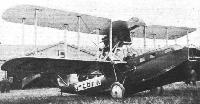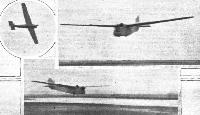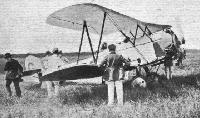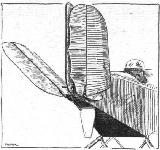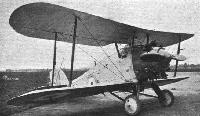Фотографии
-
Регистрационный номер: G-EBCA, E5956 THE GROSVENOR CHALLENGE CUP: Dr. E. D. Whitehead Reid, who flew his own mount, seen on the left, a Renault-engined (80 h.p.) S.E.5a.
Самолёты на фотографии: RAF S.E.5 - Великобритания - 1916
-
ALEXANDRA DAY IN THE AIR: The operations of the rose-sellers are gradually extending. In our photographs are seen the bevy of beauties who went over to Paris on Wednesday, June 13, in the special Rolls-Royce Handley Page aeroplane.
Самолёты на фотографии: Handley Page H.P.18 (W.8) / H.P.30 (W.10) - Великобритания - 1919
-
The Grosvenor Cup. In Birmingham Control. F. P. Raynham (on right), who secured second place, with his mechanic busy running over the engine
Самолёты на фотографии: Avro Avro 504 - Великобритания - 1913
-
THE GROSVENOR CHALLENGE CUP: Preparing some of the machines before the start at Lympne. From left to right may be seen the Sopwith "Gnu" (Longton), the Bristol monoplane (Foot), and a 504K Avro (Hamersley).
Самолёты на фотографии: Avro Avro 504 - Великобритания - 1913Bristol M.1A / M.1B / M.1C - Великобритания - 1916Sopwith Gnu - Великобритания - 1919
-
Регистрационный номер: G-EBFK [2] The Supermarine "Sea Eagle," with Rolls-Royce "Eagle IX" engine, is being used on the route between Southampton and the Channel Islands. Note the retractable undercarriage, and the anchor lashed to the side of the boat.
Самолёты на фотографии: Supermarine Sea Eagle - Великобритания - 1923
-
Регистрационный номер: G-EBFK [2] The Supermarine "Sea Eagle" on the water: Note the wheel raised clear. The main petrol tank is mounted on the top plane.
Самолёты на фотографии: Supermarine Sea Eagle - Великобритания - 1923
-
The Grosvenor Cup. In Birmingham Control. The late Major Foot, M.C., indulging in a cigarette just before leaving. This is probably one of the last photographs ever taken of this greatly-loved pilot
Самолёты на фотографии: Bristol M.1A / M.1B / M.1C - Великобритания - 1916
-
Регистрационный номер: G-EAUM THE GROSVENOR CHALLENGE CUP: An Avro starting from Lympne. A. V. Roe's watercooled Avro Baby (35 h.p. Green), with Bert Hinkler
Самолёты на фотографии: Avro Baby / Type 534 - Великобритания - 1919
-
The Vickers "Victoria," (2) 450 h.p. Napier "Lions": A large 25-seater troop-carrier - a development of the "Vimy."
Самолёты на фотографии: Vickers Victoria - Великобритания - 1922
-
Регистрационный номер: N150 The Blackburn "Blackburn" Fleet Spotter, 450 h.p. Napier "Lion."
Самолёты на фотографии: Blackburn Blackburn / R.1 - Великобритания - 1922
-
Three views of the "Wren" in flight over Lytham sands recently.
Самолёты на фотографии: English Electric Wren - Великобритания - 1923
-
THE FAIREY "FAWN," 450 H.P. NAPIER "LION": A "land" type long-distance reconnaissance machine.
Самолёты на фотографии: Fairey Pintail / Fawn - Великобритания - 1920
-
Baron von Freyberg making a flight in the Harth-Messerschmidt glider, on the coast of the Baltic.
Самолёты на фотографии: Messerschmitt S8 - S13 - Германия - 1921
-
Регистрационный номер: G-EAGP THE GROSVENOR CHALLENGE CUP: On the left, Flight-Lieut. W. H. Longton is seen finishing, and winning the Cup, at Lympne. In the centre, the winner, all smiles, alights from his machine, a Sopwith "Gnu" (110 h.p. Le Rhone). Below, the Sopwith being taxied past the enclosures just as F. P. Raynham, the second man home, arrives (and is seen above) on his Avro (130 h.p. Clerget).
Самолёты на фотографии: Sopwith Gnu - Великобритания - 1919
-
Регистрационный номер: N126 THE VICKERS VALENTIA FLYING BOAT: Designed by Vickers and built by S. E. Saunders of Cowes, this machine is fitted with two Rolls-Royce "Condor" engines of 650 h.p. each. Successful flying tests have been carried out recently at Cowes.
Самолёты на фотографии: Vickers Valentia - Великобритания - 1921
-
THE GROSVENOR CHALLENGE CUP: On the left, C. F. Uwins about to start on Sir Henry White-Smith's Bristol "Taxi-'plane" (100 h.p. Bristol "Lucifer"), after having set his watch to official time.
Самолёты на фотографии: Bristol Taxiplane / Primary Trainer - Великобритания - 1923
-
The L.F.G. glider Phonix 3: This machine is an engineless flying boat, and is started by being towed behind a motor boat. When anchored to a buoy in a strong wind the machine will remain up as a kite.
Самолёты на фотографии: LFG Phonix - Германия - 1922
-
The Schulz glider flying along the coast of the Kurische Nehrung, a narrow strip of sand dunes separating the Kurisches Haff (in East Prussia) from the Baltic Sea. The machine has no vertical rudder, steering as well as lateral balance being carried out by means of the wing tip flaps.
Самолёты на фотографии: Schulz FS-3 Besenstiel - Германия - 1922
-
Herr Schulz, the designer and constructor of the machine bearing his name, in the seat of his glider. The primitive arrangement of the seat will be observed. The glider is controlled by two levers, one operating the wing tip flaps and the other the elevator. There is no rudder. Herr Schulz is a school teacher in East Prussia.
Самолёты на фотографии: Schulz FS-3 Besenstiel - Германия - 1922
-
HERR BERR STARTING FOR A FLIGHT IN HIS GLIDER: He got out of the rising currents, and had to alight in the sea.
Самолёты на фотографии: Berr glider - Германия - 1923
-
The Caspar seaplane: three-quarter front view.
Самолёты на фотографии: Caspar U.1 - Германия - 1922
-
THE CASPAR SEAPLANE: On the right, the machine in flight. On the left, front view; and, below, dismantling the wings.
Самолёты на фотографии: Caspar U.1 - Германия - 1922
-
THE CASPAR SEAPLANE: Sketch showing how tail is folded.
Самолёты на фотографии: Caspar U.1 - Германия - 1922
-
Caspar U.1. 50 hp Siemens Engine
Самолёты на фотографии: Caspar U.1 - Германия - 1922
-
THE MIGNET LIGHT 'PLANE: Three-quarter front view.
Самолёты на фотографии: Mignet HM-4 / HM-8 - Франция - 1922
-
THE HENRI MIGNET LIGHT 'PLANE: General arrangement drawings.
Самолёты на фотографии: Mignet HM-4 / HM-8 - Франция - 1922
-
The Parnall "Plover," 320 h.p. Siddeley "Jaguar": A small fighter, designed to ascend from and alight on the decks of aircraft carriers.
Самолёты на фотографии: Parnall Plover - Великобритания - 1922
-
Регистрационный номер: G-EADA, E4221 THE GROSVENOR CHALLENGE CUP: An Avro starting from Lympne. Sir William Letts's "504K" (100 h.p. aircooled Bristol "Lucifer"), with Capt. H. A. Hamersley up.
Самолёты на фотографии: Avro Avro 504N - Великобритания - 1920
Статьи
- Flight




